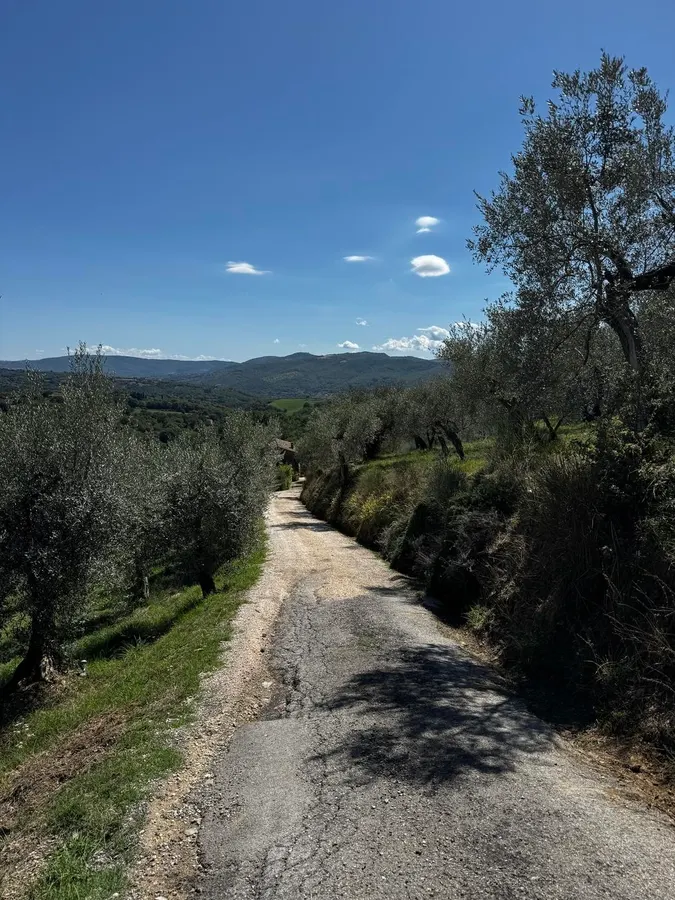By Angelina Villa-Clarke,Contributor
Copyright forbes

From the pilgrims of the Middle Ages to the aristocratic Grand Tours of the 18th century, tourists the world over have long had a love affair with Tuscany. The passion for its art, culinary offering and historic cities, have not waned, with this sun-kissed region hosting some 134 million tourists in 2023 (amounting to a total of more than 450 million overnight stays). As a result, overtourism has become a real problem, not only for visitors but for residents, with overcrowding and rising pressure on infrastructures.
An olive-tree-lined path just outside of Panicale, Umbria.
(Credit: AVC)
Known as Italy’s ‘green heart’, and now being dubbed the ‘new Tuscany’, Umbria sits within touching distance—to the east of—Tuscany. Covered in a similar landscape of verdant valleys, sunflower fields and stunning, art-filled towns, such as Assisi and Orvieto, it remains one of Italy’s least-trodden regions but boasts its own charm and ‘hidden tourist treasures’: many of which that have long remained a ‘secret’ to those ‘in the know’.
Up until recently, the choice of accommodation in Umbria mainly consisted of small boutique properties and farmhouse hotels. Putting the spotlight on the region, however, there has been a slow rise in landmark openings—from Reschio, carved out of a 1,000-year-old castle, which opened to great acclaim in 2021, to Six Senses Antognolla, slated to launch in 2026.
Rastrello has expanded with a new garden annexe.
(Credit: www.aquilamattia.it)
Found in the Medieval, hilltop village of Panicale is another new opening: Rastrello, which is perhaps Umbria’s most charming property to date. Carved out of a 14th-century palazzo, the diminutive Rastrello may be tiny, but its appeal is immense. It first opened in 2020 with nine original rooms in the main property. This year, the hotel has expanded by converting a neighbouring house and creating a new garden annexe, offering seven additional rooms, a small plunge pool, outdoor terrace area and a wellness space.
Interiors at Rastrello reflect the colours of the countryside.
(Credit: www.aquilamattia.it)
The word rastrello means ‘rake’, explains general manager Chiara Verdacchi as she leads a blind olive oil tasting, just one of the locally-focused activities for guests. It is a nod to the tool that is used to pick olives by hand during the olive harvest—an event that is integral to Umbrian life, with many smallholdings and houses, not to mention farms, across the hills, having their own olive groves and producing their own distinct olive oils.
During the tasting, you get to understand the remarkably different flavours of oils, even of those made just a few km from each other, and also the importance of the ‘liquid gold’ to Umbrian culture. The hotel also makes its own Extra Virgin Olive Oil (EVOO), with the olives sourced from 300-year-old trees on its own picturesque farm, found a short 1km walk away.
Rastrello’s concept honors the traditions of Umbria.
(Credit: www.aquilamattia.it)
Rastrello is the labor of love of Christine Wassman, who partially grew up in the area after her parents relocated from the USA to Italy in 1995. “She may as well be Umbrian, though,” says Chiara. “The opening of Rastrello has greatly benefited the community. She has a lot of support.”
Found in the province of Perugia, Panicale’s charm lies in its smallness and timeless appeal, with just 42 people living within the walls of the ancient borgo. At its heart is a sense of community. Shaped like a snail’s shell, all its cobbled roads lead back to a tiny piazza which has an ancient fountain at its heart. As well as a 16th century church, and a handful of shops and bars, it is home to the bijou 18th century theatre, one of the smallest in the country. This is Italy at its most authentic, with locals sitting oustside their houses on kitchen chairs, taking their early evening passeggiata and carefree children running around the fountain.
Thenew expansion includes a small plunge pool, ideal for cooling down on a summer’s day.
(Credit: www.aquilamattia.it)
Along one crooked street is a traditional bodega, selling cured hams, cheeses direct from farms and, of course, olive oils. “The owner was selling the shop, so Christine decided to save it,” Chiara says. “It is so important to keep these small businesses alive for the local community, especially the elderly, who would struggle to get to a big supermarket.”
As wall as employing staff who mostly originate from Panicale and the surrounding area, the hotel dedicates itself to a specific not-for-profit project each year. “We’ve just renovated a stairway to the square,” says Chiara. “You can’t open up a business in a small town like this, without care and consideration for where you are. And, importantly, we don’t want to operate in a bubble, we want our guests to be immersed in their surroundings and, for that, we need the support of locals.”
Rastrello also recently gained B Corp certification, due to its considered approach to hospitality—from its field to fork cuisine to its support for local crafts and artists, whether it is the annual opera or lace festivals that take place in Panicle.
A stay here roots you in Umbrian culture.
(Credit: www.aquilamattia.it)
From the new garden rooms, there are unspoilt views across endless olive groves, the silvery gloss on leaves catching in the sunlight. Beyond, lies Lake Trasimeno, a good spot for a day trip, with towns such as Castiglione del Lago to stroll around and ferries to take you across to a clutch of small islands.
Inside Rastrello, the décor celebrates the original architecture, with stone walls, wooden beams and restored fireplaces found throughout. Italian interior designers Pelizzari Studio were at the helm of the design of the new rooms, which have a pared-back, simple vision.
Interiors respect the ancient archtiecture of the original palazzo.
(Credit: www.aquilamattia.it)
Iron bedsteads, bare-brick walls and wooden floors give a nod to the farms that dot the countryside. Monochrome photos depict Umbrian landscapes while handmade ceramics and distressed mirrors give a wonderful rustic feel. Forest-green sofas and russet and sage textiles are also inspired by the cypress-studded countryside outside the windows.
The hotel’s restaurant Cucina & Giardino is elegant yet unfussy, with a menu that changes with the seasons. There’s melt-in-your-mouth eggplant and pecorino croquettes, an onion parmigiana and local speciality, Spaghetti alla Chitarra, which comes with a silky sauce made with garlic pesto, zucchini and Trasimeno chickpeas. Chef Nicola Fanfano’s inspiration is born in the hotel’s organic farm garden, where he sources many ingredients for his dishes. He is also diligent about using the best local producers, such as Bottega delle Carni in San Quirico D’Orcia for charcuterie, Molino Silvestri for organic flours as well as local wines from nearby estates. Inventive cocktails are also all about local flavours, with the Rastrello Martini using vodka infused with its own EVOO.
Local flavours can also be found in the restaurant.
(Credit: www.aquilamattia.it)
It goes without saying that food is one of the focuses of the in-house activities, with tours of vineyards, in-house wine tastings and truffle hunting on offer. The hotel also champions other local restaurants, such as the neighbouring Ristorante Masolino, which has a fairy-tale-like Juliet balcony overlooking the hotel’s terrace. Go here for typical, hearty Umbrian dishes, such as boar stew with juniper and flat bread, and Sassolino al Profumo di Bosco (small gnocci with a truffle and porcini mushroom sauce).
Rastrello feels like a love letter to Italy—from the complimentary early evening wine and nibbles laid out in the salon to the unique Vine Therapy Facial in the spa room. Found in the basement, the wellness room offers a choice of Umbrian inspired therapies, with this signature facial using Rastrello’s olive oil and vines from the countryside to give an indulgent spa treatment that is rooted in place.
Simple and pared-back decor brings a sense of history to the fore.
(Credit: Rastrello)
Next up, the hotel is planning to open a clubhouse, to be located close to its farm. The pink farm building, surrounded by olive trees, will be converted to house a gym, pool and pickleball court, as well as some additional rooms. The idea is that it can be visited by resident guests or exclusively hired for small weddings or parties.
“This is all about a gentle expansion,” says Chiara. “For us, it is more important to respect the dynamics of where we are: to remain in step with what has always been the charm of Panicale and the local culture. We don’t want to change anything much. We are just putting a pin in the map.”
Editorial StandardsReprints & Permissions



